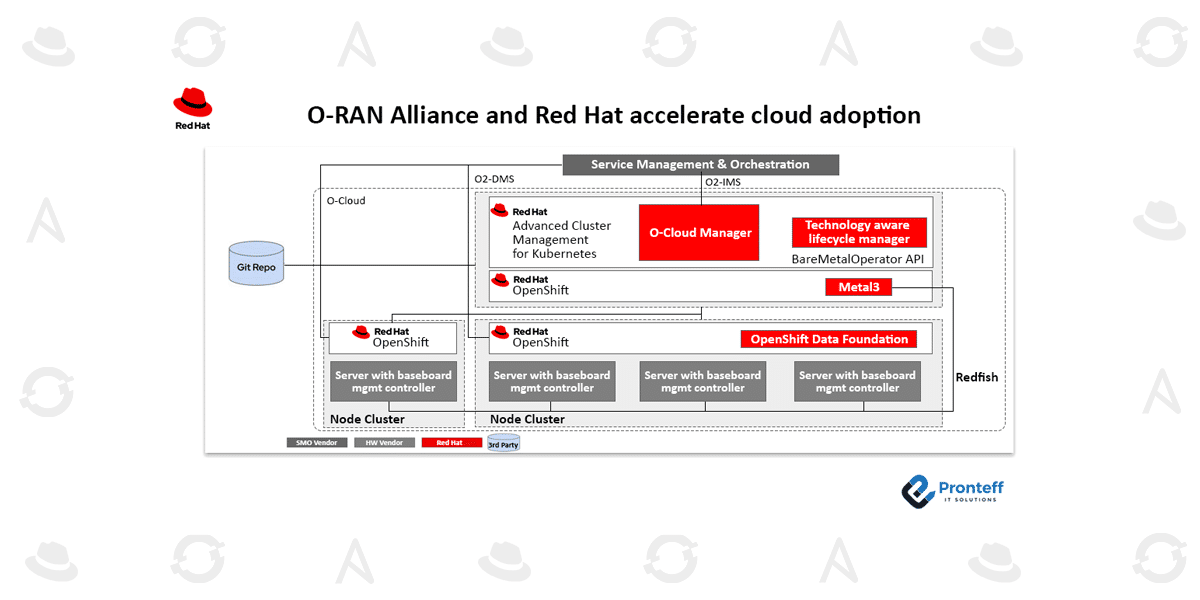O-RAN Alliance and Red Hat accelerate cloud adoption
In this blog, we will learn how the O-RAN Alliance and Red Hat Accelerate cloud adoption.
In the telecommunications industry, bringing computing power and intelligence closer to users enhances performance, reduces operational costs, and drives innovation in next-generation services. However, service providers often face complex challenges when adopting emerging technologies, automation frameworks, and modern methodologies. Every new solution must integrate seamlessly with existing radio access network (RAN) environments. To address these challenges, Red Hat has been actively collaborating and contributing to the O-RAN Alliance.
Red Hat remains dedicated to advancing the open radio access network (O-RAN) ecosystem by contributing to open source initiatives and building strong industry partnerships. The company’s efforts include developing key O-RAN interfaces, fostering a diverse hardware partner ecosystem, collaborating with service management and orchestration (SMO) vendors, and enhancing open source O-RAN projects. These advancements directly contribute to Red Hat’s cloud-native product portfolio.
Core Principles of Red Hat’s O-RAN Strategy
Red Hat’s O-RAN strategy is driven by four foundational principles—all grounded in open source collaboration.
1. Cloudification
Adopting cloud-native principles helps service providers reduce operational expenses and improve deployment reliability. Cloud-native clusters now extend across IT systems, core infrastructure, and the network edge. With artificial intelligence increasingly integrated into telecom systems, embracing these principles is essential for scalability and performance. However, service providers have faced challenges in this transition, making cloud-native adoption a critical factor in reducing operational complexity and costs.
2. Metal3 for Hardware Automation
The Metal3 project, part of the Cloud Native Computing Foundation (CNCF), lays the groundwork for consistent innovation across hardware ecosystems. It provides Kubernetes-based components for managing bare metal infrastructure. Using baseboard management controllers (BMC), Metal3 enables automated hardware lifecycle management through the O-Cloud Manager and O-RAN’s O2 interface for infrastructure management services (O2-IMS) APIs.
3. Building a Strong SMO Ecosystem
Red Hat partners closely with SMO vendors and the O-RAN community to strengthen the adoption of SMO as the framework for managing O-Cloud lifecycles. The SMO allows operators to orchestrate infrastructure and application changes through a unified dashboard. The O-RAN Alliance continues to define SMO’s essential capabilities and APIs to promote interoperability.
4. Broad O2-IMS API Use Cases
Although the O2-IMS API was designed for telecom environments, its principles apply across industries such as finance and government, addressing common challenges in infrastructure management and automation.
O-Cloud Architectural Overview
Red Hat’s O-Cloud architecture within the O-RAN framework connects key components to create a unified, automated environment:
- SMO (Service Management and Orchestration): Centralized orchestration and lifecycle management.
- O2-IMS/O2-DMS: Interfaces for infrastructure and deployment management services.
- Red Hat Advanced Cluster Management for Kubernetes: End-to-end visibility, governance, and multi-cluster control.
- O-Cloud Manager: Oversees O-Cloud infrastructure management.
- Node Clusters: Red Hat OpenShift-powered environments running container-as-a-service (CaaS) on servers with BMC.
Driving Industry Leadership and Innovation
Red Hat’s goals for O-RAN reflect its vision for openness, interoperability, and community-driven innovation:
- Ensuring alignment and compliance with O-RAN specifications and test suites.
- Expanding the hardware partner ecosystem through open APIs.
- Collaborating with partners on SMO integration via the O2-IMS API.
- Contributing to O-RAN thought leadership, standards, and software community initiatives.
Recently, Red Hat achieved full compliance with the O-RAN O-Cloud test suite using the latest Red Hat O-Cloud Manager Operator, which delivers five major capabilities:
- O2-IMS-based inventory visibility for SMO.
- Server resource reservation.
- BIOS configuration and updates (Day 0/Day 2).
- BMC and BIOS version management (Day 0/Day 2).
- Hardware enablement through Metal3 integration.
These enhancements enable full lifecycle management—from deployment to maintenance—directly via the SMO, minimizing manual intervention and significantly lowering operational costs.
Community Engagement and Open Source Collaboration
Red Hat continues to be deeply involved in the O-RAN Alliance and O-RAN Software Community (ORAN-SC), contributing to projects that bridge open source and telecom innovation.
O-RAN Alliance Working Groups
Red Hat plays an active role in WG-6 (Cloudification) and WG-11 (Security), contributing change requests, participating in weekly discussions, and influencing technical direction as a voting member.
O-RAN Software Community (SC) Contributions
- Maintaining OKD (Origin Kubernetes Distribution) builds to support continuous integration and testing.
- Supporting Solostron builds for OpenShift/OKD compatibility within O-RAN CI/CD pipelines.
- Contributing to upstream operators and compliance testing frameworks.
Proof-of-Concept and Future Direction
Red Hat’s O-RAN strategy emphasizes open collaboration and continuous technical evolution. Through partnerships and community engagement, Red Hat is shaping the next generation of telecom infrastructure—aligned with the OpenShift Platform Plus roadmap.
Red Hat envisions an open, cloud-based RAN environment that reduces operational expenditure, enhances flexibility, and accelerates innovation.
You can explore the latest Red Hat O-Cloud Manager Operator, watch the demo video showcasing full O-Cloud deployment, configuration, BIOS updates, and firmware management from the SMO—then share your feedback via GitHub issues.
Red Hat looks forward to ongoing collaboration with the O-RAN community and its ecosystem partners to further strengthen the open, cloud-native telecom landscape.








